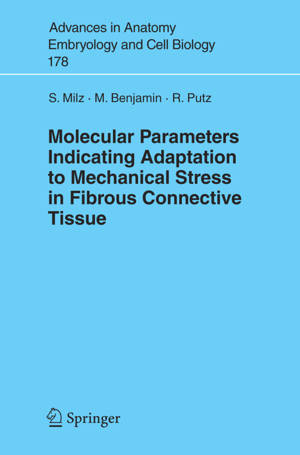
- Retrait gratuit dans votre magasin Club
- 7.000.000 titres dans notre catalogue
- Payer en toute sécurité
- Toujours un magasin près de chez vous
- Retrait gratuit dans votre magasin Club
- 7.000.0000 titres dans notre catalogue
- Payer en toute sécurité
- Toujours un magasin près de chez vous
Molecular Parameters Indicating Adaptation to Mechanical Stress in Fibrous Connective Tissue
Stefan Milz, Michael Benjamin, Reinhard Putz
167,95 €
+ 335 points
Description
1 Introduction 1. 1 General Remarks The connective and supportive tissues constitute a considerable amount of the biomass in human and animal organisms. Characteristically, the osseous, car- laginous, and ?brous tissues each connect a vital part (cells) with a non-vital part, i. e., extracellular matrix (ECM). The composition of the ECM constitutes the mechanical qualities of the respective tissue. The functional role of the bone and cartilage tissues is exhaustively discussed in the relevant literature. Whereas bone tissue provides the static and dynamic stability of the system as a whole, cartilage tissue accounts for the power transfer between bones. The articular cartilage insures a fairly friction free mobility of skeletal elements; likewise, cartilage interposed between skeletal elements allows mobility due to its reversible deformability. Under both static and dynamic con- tions, the powers transferred are remarkably large, while the ensuing mechanical force on various tissue zones varies. Tight connective tissue, especially muscle tendons and ligaments, are also part of the skeletal power transfer system. facilitating the transfer of tensile forces. The tendons of the locomotor system serve the purpose of transferring muscular - ergy to those skeletal elements to which they are attached. In this function, they are referred to as tensile tendons ("Zugsehnen"). Inseveral body parts, however, tendons appear in a peculiar mechanical situation: they pass around so-called - pomochlia, i. e., bony pulleys. Hence, these tendons are referred to as wrap-around tendons ("Gleitsehnen").
Spécifications
Parties prenantes
- Auteur(s) :
- Editeur:
Contenu
- Nombre de pages :
- 74
- Langue:
- Anglais
- Collection :
- Tome:
- n° 178
Caractéristiques
- EAN:
- 9783540244745
- Date de parution :
- 08-06-05
- Format:
- Livre broché
- Format numérique:
- Trade paperback (VS)
- Dimensions :
- 152 mm x 231 mm
- Poids :
- 204 g

Les avis
Nous publions uniquement les avis qui respectent les conditions requises. Consultez nos conditions pour les avis.






